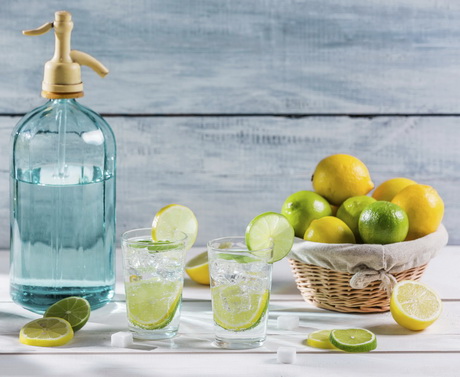
Summer is the time of refreshment drinks. Kiosks, selling carbonated water, are available at almost every park, a lot of regions are developing their own brands of “sweet water”. We are accustomed to drink lemonade, barrels with kvass can be seen on many photos, made in Soviet times.
“The place, where there is sweet water, has a lot of slim and beautiful people,” argued one of authors of medical treatises of ancient China. Hippocrates mentioned water with gas in his work “On airs, waters and terrains”. Bottling of mineral water began in the XVIII century but it quickly lost its sparkling properties and was very expensive. Artificial saturation of ordinary water with carbon dioxide was discovered in 1770. The first plant for industrial aeration of water was launched by a Swiss chemist Johann Jakob Schweppe in 1783. In 1793, the enterprising amateur scientist founded the brand — Schweppes, which still holds a significant share of the production of beverages. In the 1830s, they started adding citric acid to sparkling water, making well-familiar lemonade.
New drinks got widespread in Russia. One of Chekhov's characters was drinking “lemonade-gazes with cognac”. Characters of Pushkin's “Queen of Spades” and Lermontov’s “Masquerade” are fans of lemonade as well. Alexander Pushkin, probably, drank the carbonated drink before his fatal duel, “after drinking a glass of water or lemonade, Danzas (Konstantin Danzas was a friend of the poet) couldn't remember, Pushkin went out of the pastry shop with; they sat in the sled and drove to the Trinity Bridge”.
Fruity kvass was a direct competitor of lemonade in the Russian Empire. In Moscow alone, they produced drinks, based on wild ash, cherry, blackcurrant, cranberries, apples, pears. In 1913, a doctor wrote a thesis on kvass in St. Petersburg. A physician V.S. Sotnikov conducted a study of drinks, produced in monasteries, at local residents’ houses and at factories. He came to a sad conclusion, “Good kvas deserves precedence over any lemonade, because it contains a greater number of nutrients, albeit minor but more evident, compared to lemonades. Besides, kvass quenches thirst better”. In 1911, Gazeta-Kopeyka (popular newspaper) published the information that dishonest merchants supplied banned then saccharine in up to 37% of drinks.
Lemonade often became a side product for owners of breweries. In Armavir, there was an ad about “soft drinks, made from pure refined sugar with distilled water of real fruit and berry juices”. A bucket of champagne drink and sitro cost 2 rubles. Products of Novaya Bavaria and Kalinkinsky Beer and Honey Brewery Partnership were very popular in St Petersburg. During the World War I, when the Empire imposed a “dry law”, people tried to mix lemonade with alcohol. In 1914, an enterprising owner of a beer pub in Yekaterinoslav sold alcohol to customers, demanding for Fialkovsky’s Lemonade — this phrase became a password to get a drink with alcohol.
Any mineral water in Russia was often referred to as “Selter”. This didn't meant that it was produced at water spring Niederselters in Germany. It happened that one of the most popular brands gave the name to the entire product. For a similar reason, in the 1980-1990s, a copy printer was called a xerox, although the company Xerox was not the sole player in the market. Selter water and lemonade were necessary elements of any buffet, ball, picnic, etc.
One of the most successful Russian entrepreneurs on the market of fruit waters was Mitrofan Lagidze. He started his career as an apprentice pharmacist in a drugstore, where he observed the production of syrups. In 1900, the novice businessman opened his first factory in Kutaisi, then he moved to Tbilisi. A shop under the title “Lagidze’s Waters” appeared in Rustaveli Avenue. The businessman secured his success with gold medals, his product was highly praised at national and even international exhibitions. His lemonade was sent to the court of Nicholas II and an Iranian Shah. It is amazing but even in Soviet times Mitrofan Lagidze went unhurt, he even built up the turnover — drinks from his factory were supplied by air to Moscow, recipes were included in books, Lagidze’s lemonades were served to high-profile guests of the Yalta Conference in 1945.
The Soviet Union had impressive facilities for the production of non-alcoholic carbonated beverages. In 1973, the production of Baikal, carbonated water with St. John's wort extract, was launced. The conveyor production of Tarkhun (tarragon) was mastered in the 1980s, while Mitrofan Lagidze used that Caucasian herb even in the late XIX century. The drinks Buratino and Sayany were very popular, “We were sitting on a bench near the shooting site, drowsy with heat and drinking Sayany from bottles. Ten years later, in the city of Sofia... snack bars and restaurants had ad posters on their walls, in a formal Communist style, promoting the new drink Sayany: “Tonic qualities are similar to the well-known Coca-Cola with a much better taste”. Then we did not know it and were just drinking sweet moisture, pointlessly looking at the absolutely flat, grey with white sun, still, shallow sea,” wrote Anatoly Nayman.
In the times, when Nikita Khrushchev governed the country, vending machines with carbonated water appeared in the streets. Moscow alone had more 10,000 such machines. Inside there was a container of syrup, a carbon dioxide saturator and a water fountain, where you could wash the glass. A glass of carbonated water with syrup cost 3 kopecks, without syrup — 1 kopeck. Some craftsmen tied a coin to a string and saved on pay. Some enterprises provided carbonated water for free. In the 1990s, those vending machines with carbonated water almost vanished from the streets of Russian cities. In recent years, when the Soviet daily life “renaissance” began, lemonade and soft drinks have again been sold via vending machines.
Pavel Gnilorybov,
historian in Moscow Studies, Mospeshkom project coordinator


Comments (0)
Twitter
Facebook
Pinterest
E-mail